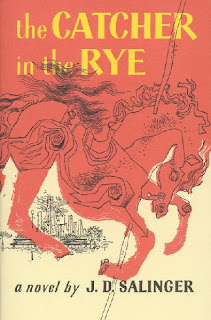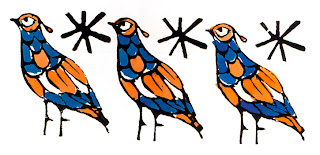
J.D. Salinger reveals in the novel The Catcher in the Rye that the difficult process of maturing into adulthood is a necessary and unavoidable part of life that reveals inevitable truths about human nature through the characterization of the main character, Holden. Holden is a troubled teenage boy who constantly struggles with the idea of leaving the innocence of his youth because he begins to see the corruption of the adult world. Holden shows he needs to attain closure to his childhood and innocence before he can move on to adult life when he writes “What I was really hanging around for, I was trying to feel some kind of a good-by. I mean I've left schools and places I didn't even know I was leaving them. I hate that. I don't care if it's a sad good-by or a bad good-by, but when I leave a place I like to know I'm leaving it. If you don't, you feel even worse (1). In his attempts to “say goodbye” to his childhood, Holden throws himself into an adult life in which he is forced to leave the innocence of childhood. The struggling teen is caught in a struggle between leaving his youth and entering adulthood and therefore feels he needs to “catch everybody if they start to go over the cliff— I mean if they’re running and they don’t look where they’re going I have to come out from somewhere and catch them. That’s all I’d do all day. I’d just be the catcher in the rye and all” (22).Holden feels he needs to take the responsibility of protecting the innocence of children, such as his sister Phoebe, in hopes that they do not fall off the cliff into adulthood such as he was forced to do. Near the end of the novel, Holden begins to accept maturing into an adult is unavoidable and though making the transition into adulthood can be troubling and frightening, he realizes it is a necessary step one has to take. By showing readers the changes and choices one has to make from childhood to adulthood in The Catcher in Rye, J.D. Salinger reveals growing up is a difficult time in which one is force to come cold realizations of adult life.
Sunday, May 18, 2008
8 Sentence Paragraph on Characterization in The Catcher in the Rye
Posted by
Lauren Finke
at
9:14 PM
0
amazing comments
![]()
Saturday, March 8, 2008
Wednesday, February 6, 2008
Reflection on Hemingway’s “In Another Country”
 While reading Ernest Hemingway’s “In Another Country,” I was impressed with the unique viewpoint taken in the story. Not only is the point of view of a soldier, it is also a perspective of a man who is out of place even with men of his own kind who have been wounded just as the narrator had been. The idea that the narrator really has no one whom he can truly relate to emphasizes the rather gloomy mood of the story: “I was a friend, but I was never really one of them after they had read the citations, because it had been different with them and they had done very different things” (734). I that the foreign soldier’s seclusion and air of hopelessness helped to emphasize the cynical mood of the story that was characteristic to the modernism time period.
While reading Ernest Hemingway’s “In Another Country,” I was impressed with the unique viewpoint taken in the story. Not only is the point of view of a soldier, it is also a perspective of a man who is out of place even with men of his own kind who have been wounded just as the narrator had been. The idea that the narrator really has no one whom he can truly relate to emphasizes the rather gloomy mood of the story: “I was a friend, but I was never really one of them after they had read the citations, because it had been different with them and they had done very different things” (734). I that the foreign soldier’s seclusion and air of hopelessness helped to emphasize the cynical mood of the story that was characteristic to the modernism time period.
As I read through “In Another Country,” I was also impressed with the symbolism Hemingway used in the machines to deepen the mood of hopelessness. The machines were viewed as objects meant as hope yet only really deepened despair and hopelessness. This fall of hope to despondency reflected the era of writing at that time. The hope that the doctor brought was shattered by the realities the soldiers faced. I was most impressed with the feelings of Hemingway during his war years being connected to the feelings of the hopeless and despondent soldier in the story. I believe Hemingway did a splendid job in reflecting the uncertainty he perhaps felt during the war in the foreign soldier’s character. The Modernistic period of writing was reflected well in a story that I felt was worth my time reading.
Posted by
Lauren Finke
at
10:27 PM
0
amazing comments
![]()
Saturday, January 12, 2008
Argumentative Essay on The Awakening
 A Spanish Proverb written long ago plainly expresses what women seeking to become equal might agree upon: “To tell a woman everything she may not do is to tell her what she can do.” Female characters such as Edna Pontellier, whom longed to be free women in society, would likely have agreed with this famous Spanish proverb for they desperately wanted the rights men in society had. Women sought to be free and independent citizens just as men were. To find their freedom and place in society, women often felt lost in their pursuits to find their identity. The novel The Awakening is a good example of the Realism period because Kate Chopin expresses views of the feminist movement through the characterization of Edna as well as through the use of symbolism in birds throughout the novel.
A Spanish Proverb written long ago plainly expresses what women seeking to become equal might agree upon: “To tell a woman everything she may not do is to tell her what she can do.” Female characters such as Edna Pontellier, whom longed to be free women in society, would likely have agreed with this famous Spanish proverb for they desperately wanted the rights men in society had. Women sought to be free and independent citizens just as men were. To find their freedom and place in society, women often felt lost in their pursuits to find their identity. The novel The Awakening is a good example of the Realism period because Kate Chopin expresses views of the feminist movement through the characterization of Edna as well as through the use of symbolism in birds throughout the novel.
The transformations Edna makes in her character throughout the novel reflect the realism period’s feminist movement. Edna’s awakening gives her a newfound outlook on society and the desire to seek alternative roles within that society (Gray 1). Once Edna becomes awakened to her own desires, she begins to search and experiment with alternative roles in society. Edna begins to question and experiment with new roles for women that were often not accepted in the nineteenth century. Chopin expresses what women of the feminist movement were experiencing when she writes “Mrs. Pontellier was beginning to realize her position in the universe as a human being and to recognize her relations as an individual to the world within and about her” (Chopin 17). Like most women in the nineteenth century feminist movement, Edna comes to the realization that society has chosen a place for her. Instead of accepting what society has given her, she desperately devotes her life to making her own choices and decisions. Edna’s transformation from acceptance of society’s ideas of women to her realization that she must make her own decisions to be heard strongly reflect the ideas of the feminist movement of the 1800’s.
The use of birds in The Awakening symbolizes how women were kept in cages and examines the obstacles they encounter when they attempt to escape. Elz argues Chopin’s use of birds symbolize women’s entrapment in society and uses the caged bird to show that women are not merely to be admired or dismissed when bored, but should be an important, continuing presence in society (Elz 2). The parrot speaking an incomprehensible language symbolizes how women, such as Edna, were not understood by the remainder of society when they attempted to voice their opinions. Edna, just like the birds, has trouble communicating her feelings and is unheard in her attempts to express her thoughts and feelings. In the novel Madam Reisz, a strong, unrestrained woman, informs Edna she doesn’t have strong enough wings to sustain flight (85). In Edna’s attempts to escape, she is wounded because her wings are not strong due to her confusion about her identity. She is not able to handle what comes along with rejecting society and making her own path because she is not completely sure of herself. The symbolism of birds in the novel portrays the struggle women felt within the barriers society erected for females.
The Awakening by Kate Chopin effectively expresses the feminism of the realism period through the use of characterization of Edna as well as the symbolism of birds in the novel. Through the transformations of Edna’s character, Chopin demonstrates how women of the realist period were viewed and how they ultimately viewed themselves. Kate Chopin urges women to follow the feminist notion to follow not what society has given them but to follow their own path to freedom. The Awakening is a novel that encourages women to explore their own identity in society instead of allowing society to cage them. While most remarks concerning women’s rights would today be considered normal, the mere thought of changing women’s roles in society in the nineteenth century was considered extreme. The feminists of the 1880s set a remarkable example that people should always examine their roles in society and decide for themselves the manner in which they, as an individual should live.
Posted by
Lauren Finke
at
5:02 PM
0
amazing comments
![]()
Saturday, December 29, 2007
Ramblings of Christmas Break
I hope everyone's winter vacation went great!I know we all deserved and needed the break! Isn't the picture on the right gorgeous?That's Huntington on my Birthday. As expected, the beach was almost completely empty the day after Jesus' Birthday. We did see a kitesurfer and I made a promise to myself that I would learn to kitesurf. I mean soon. It was very cool. I ate at the best bar-b-que place ever and wondered why they abbreviate bar-b-que because when you put in the -'s, it takes up the same amount of room as when you spell it. I was given a Nixon watch which was "the cheese to my macaroni."*
*My new found habit is quoting movies and making pop culture references. I don't know why. It is actually sorta embarrassing.
Posted by
Lauren Finke
at
10:43 AM
2
amazing comments
![]()
Monday, December 3, 2007
Reflection on "The Notorious Jumping Frog of Calaveras County"
 While reading "The Notorious Jumping Frog of Calaveras County," I was amused by Mark Twain's use of diction and humor used to entertain readers throughout a monotous account. The author's sarcastic, dry humor allows for the story to encourage readers to continue with the story and pokes fun at an otherwise boring cast of characters. Through the use of diction, Twain develops the characters of the story into a humorous cast that brings color to the story.
While reading "The Notorious Jumping Frog of Calaveras County," I was amused by Mark Twain's use of diction and humor used to entertain readers throughout a monotous account. The author's sarcastic, dry humor allows for the story to encourage readers to continue with the story and pokes fun at an otherwise boring cast of characters. Through the use of diction, Twain develops the characters of the story into a humorous cast that brings color to the story.
Posted by
Lauren Finke
at
6:35 PM
2
amazing comments
![]()
Sunday, December 2, 2007
Reflection on "The Outcasts of Poker Flats"
While reading "The Outcasts of Poker Flats," I was impressed with the way in which the author presented the idea that no matter how strong or weak, good or bad a person may be, everyone faces death of their lives on earth. The author presented characters each unique from each other such as "the innocent" Piney, the adulterous Duchess, the quarrelsome Uncle Billy, and the calm Mr. Oakhurst. These characters were each very different form each other presenting multiple foils to each other in both intellect and physical abilities. The one thing they did all have in common was the world's rejection of themselves and their ironic strikes of bad luck. Harte uses the characterization of all of the characters in his story to show now matter how different man may seem from each other, they are closer to each other than they may seem.
Harte continues with his idea about man's fate and equality when Mother Shipton, the supposed strongest of the group, perishes. This contrast to the idea of the stronger will survive is extinguished as Harte reinforces the fragility of human life.In the end, Duchess and Piney, two completely opposite characters morally, die in each other's arms. Though direct foils of each other in virtually every aspect, the two suffer the same fate. Later, the cool headed Mr. Oakhurst is found dead after a successful suicide attempt. Before the unfortunate event of being outcast took place, the fate of the characters would never have been guessed to have such an unfavorable outcome.
By giving all the characters in his story such a terrible fate, Harte reinforces the idea that humans are immortal. We all share a common thread, just like the characters in the story were all outcasts. Through the use of characterization, Harte shows that everyone will eventually die here on this sinful earth: "But all human stain, all trace of earthly travail, was hidden beneath the spotless mantle mercifully flung from above" (Harte 541). The author shows his readers exactly how fragile life can be and the fate of human immortality. Whether we consider death the actual "end" or the start of a new life, however, is left up to the readers.
Posted by
Lauren Finke
at
10:20 PM
0
amazing comments
![]()

